Marek Sobczyk “Painting without Metaphor, Metaphor without Painting”
Curator: Waldemar Baraniewski
8.12.2022 – 26.01.2023

fot. Jakub Seydak
Waldemar Baraniewski
Something in between
“What stories about pictures want is to be read – writes J. Hillis Miller – just as pictures want to be viewed. The picture asks, demands, implores that I look at it. (…) What is a story that is not read (…)? What is a picture that is not looked at, that, so to speak, has its face turned to the wall? (…) Reading or looking, in each case, seem to complete a purpose that is not so much that of the writer or painter as a need intrinsic to the works themselves.”[1]
Pictures want to be looked at. But images are never simple ‘visibility’. Rather, they are a complex discursive practice in which visual and textual elements form a series of interrelated relationships. In the famous book What Do Pictures Want W. J. T. Mitchell, who creates the intellectual figure of the “desires” of images, replies: “What pictures want in the last instance, then, is simply to be asked what they want, with the understanding that the answer may well be, nothing at all.”[2]
Why does a painter paint pictures? What is the purpose of this practice? Of course, each author will have his own answer to these questions. Marek Sobczyk is an artist who engages himself through painting in the complex issues of modernity. His paintings are also complex. Discursive, erudite, made of various elements of reality. The artist writes about himself: “I treat paintings and the convention of painting itself as a language that contemporises the problems of visual art across time or through time, at the same time generally contemporising other issues – all encountered, not only in the field of visual art; the contemporary politics of the contemporary means of art.”[3]
For Sobczyk, activity in the field of art means work on language. Sobczyk compares it to building a house, when one needs to choose a place, dig a foundation, erect walls and a roof. Language should be effective, it should function well and serve the work. “The components of this language”, he writes, “are something in between: between image and symbolisation; between a letter of the alphabet as a pure abstraction and a word from the written language (a written word) or a word from the spoken language (a spoken word); between the artistic means and a living artistic language; something between the days and hours lived by an artist and a lie and an error ”.[4] Language should be the language of consent, of constructing a message, of building a metaphor. This is also the purpose of the “organising principle”, method, discipline. Through it, the artist reveals what he represents and with what. It is possible, among others, by the “Table What? Who? – With What? With Whom?”, which offers a very wide range of possibilities of applications of the “means of art”, of joining “conceptual domains”, and thus, in essence, of facilitating cognition. It is a practice similar to creating metaphors that also serve cognition. They facilitate cognition.
One of the ways is also by “writing words next to images (…) persistently confirming an image with a written word”.
Sobczyk is fascinated by the “area between word and image”. As he writes: “sometimes in a painting you can see words, just words. Of course, a painting is a painting, I painted a word or not, but the painting is the most important. This emphasis that the painting is the most important thing… In general, this tracking of the words, this being vigilant – is a painter’s work. Something craftsmanly-impossible. Doing something that cannot really be useful as an object, as a thing, and of which only usefulness is as art, which is something that does not have a physical existence”.[5]
Sobczyk comments on his works. Comments are to some extent a component of, a complement to visual structures. They form a unity with them. Just like verbal narratives of Sobczyk, who “shows around” his imaginary worlds, in which words and sounds are layered like in a palimpsest, visible through each other. The egg tempera used by Sobczyk, as he writes: “by working with light, makes layers of painting and metaphor visible”. It also makes possible for someone to see something that is the result of turning speaking into seeing. In what way the artist achieves this, remains the mystery of his art. How, within what limits does a painterly representation allow one to see the sound of words, to show what Louis Marin formulates as a hypothesis – “the task of painting is to try to make the power of voice visible.”[6]
“Sobczyk’s pictures”, writes Stach Szabłowski, “are never projections or illusions; in this context, the painter’s choice can be understood as taking the side of realism, or more precisely, of the real presence of motifs on the surface. Quoting, in turn, is the procedure of inviting reality onto the surface of the painting. What is this “reality”? What resources does the painter draw from?”[7]The best answer is: from any. There is no particular area from which inspiration would come. Sobczyk “sublimates” the whole reality, in its temporal, cultural, biological, social, political differentiation and stratification. His analytical projects – research, painting-discursive realisations are often continuous, unlimited undertakings. But even so, the image is always the most important. Sometimes a commentary or personal remarks indicate the source of motives, themes, specific realisations. This is the case, for example, with the painting The Holy Family, about whose origins the author wrote: “The Holy Family – Saint Joseph a carpenter cuts the beam for the cross, the Lamb of God, a shepherd takes care of the lambs, he works with the lambs, the Mother of God, a Woman and Arachne, weaves the thread from the wool of the lamb she gave birth to. There was a painting, an oleo-print, black and white above a bed in an apartment that I was occupying for a month. I slept for a month under this kitsch painting, which, after all, I experienced strongly enough to be inspired. I do not laugh at the Holy Family, I am very attached to the idea of a respect due for this figure, which, indeed, I also share. Although even before, there had been thoughts whether one could compare St. Joseph to Geppetto, because of the profession and the realisation of a certain project – despite everything.”[8] This comment and the disclosure of the painting’s origin very accurately indicate Sobczyk’s working method.
But also – as he himself notices – an openness to risk. “Getting involved”, he writes, “a style of a certain risky pretension has become a permanent and a very clear element of my work.”[9]
And we, following Mitchell’s advice, let’s ask the images what they want. It is always worth experiencing and waiting for the answer.
[1]
J. Hillis Miller, What do Stories about Pictures Want?, “Critical Inquiry” 34, 2008, p. 59.
[2]
W.J.T. Mitchell, What Do Pictures Want?: The Lives and Loves of Images, Chicago, The University of Chicago Press, 2005, p. 48.
[3]
M.Sobczyk, Sawwatokýriako [w weekend sztuki], Warsaw, MAMMAL Foundation, 2021, p.5.
[4]
M. Sobczyk, Obraz, in: Exhibition catalogue: Jarosław Modzelewski, Marek Sobczyk. Obrazy namalowane wspólnie. Obrazy namalowane osobno., Poznań, Gallery at the Jesuits, Centre for Christian Culture, no publication date, p.8.
[5]
Ibid., p.9.
[6]
L. Marin, Na marginesach obrazu: zobaczyć głos, in: L.M., O przedstawieniu, Gdańsk 2011, pp. 394-411 (own translation).
[7]
See, M.Sobczyk, Sawwatokýriako [w weekend sztuki], op. cit.
[8]
See, M. Sobczyk, Obraz, op.cit.
[9]
See, Ibid.

fot. Jakub Seydak
Marek Sobczyk
Born on 30 November 1955 in Warsaw. In the years 1975-1980 he studied at the Faculty of Painting of the Academy of Fine Arts in Warsaw, where he obtained a diploma in the studio of Prof. Stefan Gierowski. Since 1983, he has been associated with the Warsaw artistic formation Gruppa and has participated in all of its actions. From 1989, he has been involved in graphic design and typography (Zafryki studio with Piotr Młodożeniec till 2004), creating original typefaces. Since 1982, Marek Sobczyk and Jarosław Modzelewski have been several times engaged in painting together. Between 1990 and 1997, together with Jarosław Modzelewski, he ran the private Szkoła Sztuki / School of Art. He concerns himself with art theory and intellectual reflection on the fundamental problems of artistic creation. He has published: Course in Abstraction (1996) and after a year-long series of lectures at Zachęta – National Gallery of Art in Warsaw – Course in Sublimation (2006). He has been conducting a number of artistic projects: Research on the Brain in Poland (since 1979), Table What? Who? – With What? With Whom? (since 1998), Sexreligionpolitics (since 1999), Monuments of Discourse (since 2008), Around the Word “Atheism” (since 2009). Since 2003 he has been carrying out a multi-year project “Museum” in Quotation Marks. Together with Mateusz Falkowski he is the author of the concept and of the Manifesto of Gravity Cinema. In addition to painting, Sobczyk creates installations and spatial objects. In 1991 he made Simple Rainbow which stood in front of the Zachęta Gallery till 1993. Re-set in 2019, was removed in 2022 under a new director of the Gallery. In 2013 he became the laureate of the Jan Cybis Award.
Selected solo exhibitions (since 2011):
2011
Research on the Brain in Poland [Complex Paintings], Academy of Fine Arts Gallery, Cracow
Twice Too Many Pictures [Research on the Brain in Poland], aTak Gallery, Warsaw
2012
Jémni, Polish Intitute in Prague
Wateizmrszateizmwateizm (actions with letters), the artist’s studio, Warsaw
Marek Sobczyk – Research on the Brain in Poland 1979-2012, BWA Gallery, Legnica; BWA Gallery, Jelenia Góra
2013
Marek Sobczyk. Research on the Brain in Poland 1979-2012,Książ Castle, Wałbrzych
Research on the Brain in Poland 1979-2013 [Pinacotheca], Dap Gallery, Warsaw (exhibition after winning the Jan Cybis Award)
2014
Human and Civic Rights of Artistic Means [Politics] (with J. Modzelewski), Wizytująca Gallery, Warsaw
Bau hau hau, Milano Gallery, Warsaw
2015
“Museum” in Quotation Marks, Zachęta – National Gallery of Art, Warsaw
2016
Table What? – What With? [Politics] (with J. Modzelewski), Center for Contemporaty Art Łaźnia, Gdańsk
Around the Word “Atheism”, BWA Gallery, Gorzów Wielkopolski
Gravitation Cinema Exhibition and Workshop (with M. Falkowski), Gallery of the Faculty of Painting of the Academy of Fine Arts, Cracow
“Museum” in Quotation Marks [Works from Two Editions of the “Museum” from 2006 and 2015], Municipal Gallery Arsenał, Poznań
2017
The Weight Loss Collection, Piktogram Gallery, Warsaw
Zero Tolerance for the Church, Zero Tolerance in the Church, Otwarta Pracownia Gallery, Cracow
230×180, Contrast Gallery, Warsaw
Geography of Finnish Houses [Gravity Cinema Workshop] (with M. Falkowski), the Finnish houses in Jazdów, Warsaw
Wedding Called Off, Kronika Centre for Contemporary Art, Bytom
Eve of the Avant-Garde [Activities with Gravity Cinema] (with M. Falkowski), Institute for Polish Culture of the University of Warsaw, Warsaw
2018
“Museum” in Quotation Marks [Work in Kielce], XS Gallery, Kielce
2019
The Year of Sculpture, BWA Gallery, Zielona Góra
The Year of Sculpture [Work in Warsaw], Szydłowski Gallery, Warsaw
Simple Rainbow (1991-2019 Reconstruction), Małachowskiego Square, in front of the Zachęta – National Gallery of Art, Warsaw
Marek Sobczyk: 2015-2019 [The Longer Life of Every Picture] [Android], The City Gallery in WrocławCINEMA, Milano Gallery, Warsaw
2020
Kuda Gierman (with J. Modzelewski), the Stefan Gierowski Foundation, Warsaw
2021
Marek Sobczyk. Savvatokýriako [The Means of Art at the Weekend], Wizytująca Gallery, Warsaw (as a part of the Warsaw Gallery Weekend)
2022
A Trip on the Wire [Polentransport], Muzueum Sztuki in Łódź
Working Mode [Shock] (with J. Modzelewski), SZOKART Art Gallery, Poznań

fot. Jakub Seydak
Exhibition duration: December 8, 2022– January 26, 2023
Exhibition opening: Thursday, December 8, 2022, at 7 pm
Organizer:
The Jan Tarasin Art. Gallery in Kalisz
Culture Institution of Kalisz
Exhibition Partner:
Foundation MAMMAL
Gallery Partners:
Ergo Hestia, Polifarb Kalisz S.A., M&P Alkohole i wina świata
Media Patronage:
Magazyn SZUM, NN6T, Radio POZNAŃ, Ziemia Kaliska, Calisia.pl, radio Centrum








